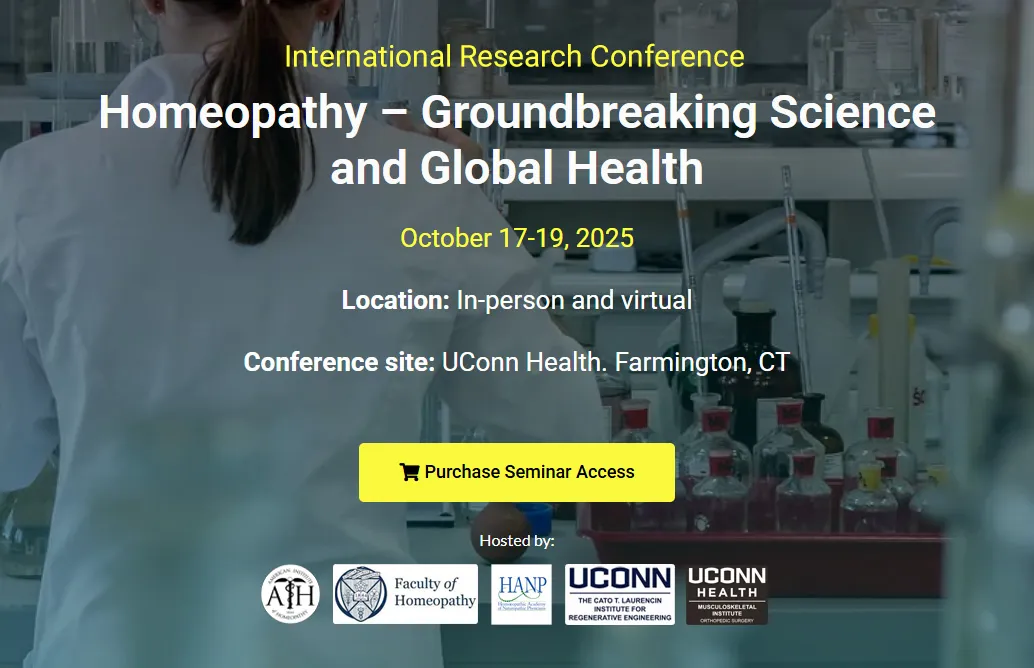A review of basic science research in homeopathy. Part I
Saturday, October 18 / 1:15 PM – 2:00 PM
The theories and models of homeopathy: what do we know?
Speaker: Alex Tournier Ph.D.
Presentation focus: There is currently no generally accepted theory able to explain the observed clinical efficacy of homeopathy. We present our scoping review which aims to identify all theoretical approaches that have been used to explain homeopathy, with the objective of helping future theory elaboration and experimentation.
Methods: Medline, Embase, Scopus, Web of Science, PhilPapers, several online library catalogues, and personal libraries were searched for original studies up to 12th July 2024. The theories identified in this review were grouped into fourteen overarching theoretical frameworks.
Results: 2118 records were screened, 500 full texts were assessed for eligibility, and 216 studies were included in this review. Starting in 1832 until the late 20th century, only sporadic contributions were found. From the 1990s, a marked increase in scholarly output was recorded. The frameworks with the highest number of contributions were Humanities, Complex Systems, Water Structures, and Weak Quantum Theory. 22% of included publications described theoretical approaches that tried to cover both main aspects of homeopathy, 46% only Potentisation, 20% only the Principle of Similars (and 11% were unspecific).
Conclusions: This scoping review offers an overview of theories and models on the mode of action of homeopathy. Unexpectedly, the placebo did not emerge as such a framework.
The electrical, magnetic and photonic properties of homeopathic potencies
Speaker: Steven Cartwright Ph.D.
Presentation focus: Studies on homeopathic potencies using solvatochromic dyes have provided results that indicate remedies both produce an electrical field, and are stabilised and enhanced by applied static magnetic fields, whilst being negated by the application of an electric current.
Aims and Methods: Guided by these studies, parallel investigations have been conducted with an ultra-sensitive, extended range luminometer capable of detecting low level photon emissions and separately, ferric oxide nanoparticles of an average size of 10nm have been used to detect changes in ambient magnetic fields associated with potencies. Throughout the above investigations potencies of Arsenicum album have largely been used in order to be able to draw direct comparisons between the results of different investigative methods, supplemented with potencies of other remedies as required.
Results: Weak photon emissions in the UV and visible regions of the electro-magnetic spectrum have been detected from a range of potencies of Arsenicum album on application of an electric current. In addition, ferric oxide nanoparticles show changes in their spectra in the presence of potencies of Arsenicum album consistent with a weak magnetic field.
Discussion and Conclusions: The results obtained using luminometry and with ferric oxide nano particles complement and extend results already obtained using solvatochromic dyes. The range of data now available from these studies shows how the electrical, magnetic and photonic properties of potencies might interact and be common expressions of an underlying dynamic structure.
Keywords: Solvatochromic, Luminometer, Electrical, Photons, Magnetic
The science behind Homeopathy – an overview
Speaker: Papiya Nandy Ph.D.
Presentation focus: Homeopathic medicines, despite scepticism and challenges have persisted over 200 years, with recent research bringing them into the scientific fold. Ultra low dosages of drugs where the presence of original molecules is improbable has shown some significant benefits. This has prompted renewed interest in exploring the physicochemical nature and mechanism of such dilutions in biomedical and healthcare applications.
The medicinal property is obtained by serial dilution of the mother tinctures derived from inorganic /organic/ nosodes substances , chosen from the principle of “ similia similibus” or” like cures like” . It is diluted in water or in alcohol and then followed by vigorous shaking. two together being known as potentisation, giving rise to nanoparticles.
The decrease in size of the drug associate (Y) with an increase in potency (X) bears an empirical relation
Y= a X -n
where a and n are characteristic of each drug.
Dilution and succussion : These are the two most important basic things. First is law of similars ( the likes behave as likes- the material is chosen for the selection of the mother tincture) and the serial dilution in water or in ethanol, followed by mechanical vibration, The two together, known as potentisation. Potentisation dissociates the structure of medicine to nanoparticle and it forms coherent domains (CD) in the liquid, trapping energy from ambient electromagnetic field.
CD has long life as it cannot release the trapped enegy by thermal radiation. But it can do so through guest molecules(present in the form of impurity or deliberately added solute material, the medicine)
The succussion dissociates the structure of medicine(2019, MedCrave IJ Complementary & Alternative Medicine 12(6), 221-223 )
Using some metal derived homeopathic medicines, it has been shown that when they are embedded in electroactive polymers, the conductivity and dielectric constant increase by several orders of magnitude ,making them a useful candidate for electronic industry (2017 , Homeopathy 102(4) 262-267)
According to QED, the water molecules can stay in the coherent domain (CD) or as individual water molecules. In presence of environmental electromagnetic field, the domains oscillate, giving rise to an extended coherence domain- a dissipative structure(DS). The succussed serial dilution in proper solvent carries the information about the solute via DS.
Change of structure of the medicine and its environment have been studied by different physical methods : NMR, DLS, AFM, Raman spectroscopy , Anomalous Dielectric Dispersion Detector and other studies.
One important part is that quantum particles are the ultimate constituents of all living and non-living objects. These energy states are represented by wave functions (WF). Following the principle of Quantum Entanglement (QE), any two or more particles may be linked up in a certain way, and become entangled or coherently coupled for a long time.
Following are the specialities of homeopathic medicines. The research works demonstrating the science behind homeopathy have been carried out in different laboratories and are summarised here in which the following author had been a co-author.


